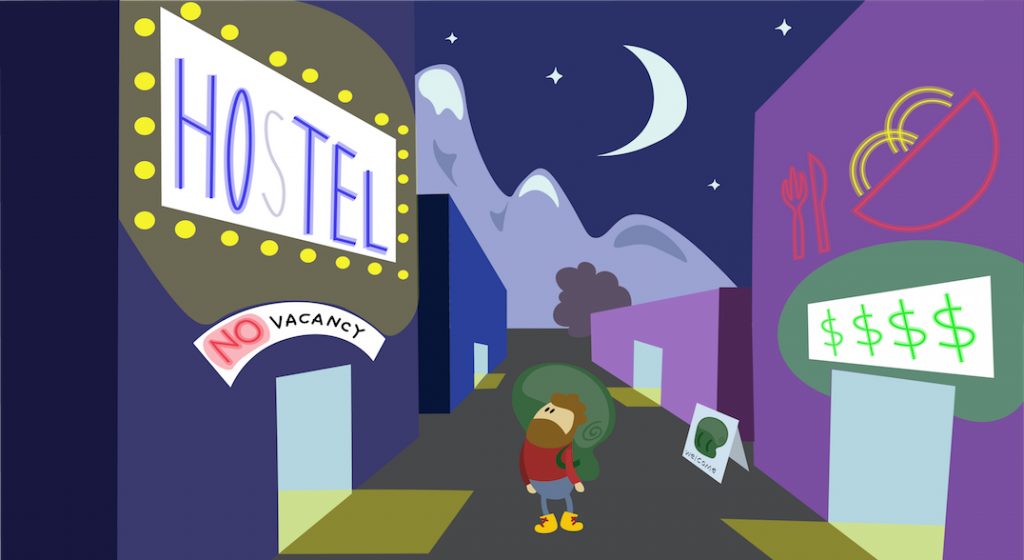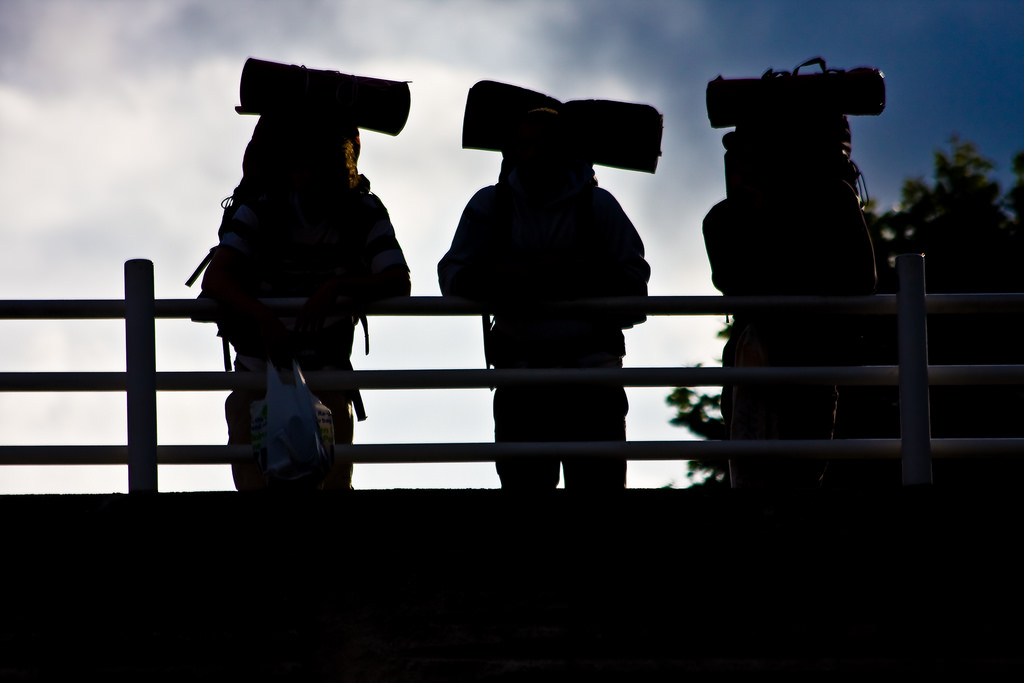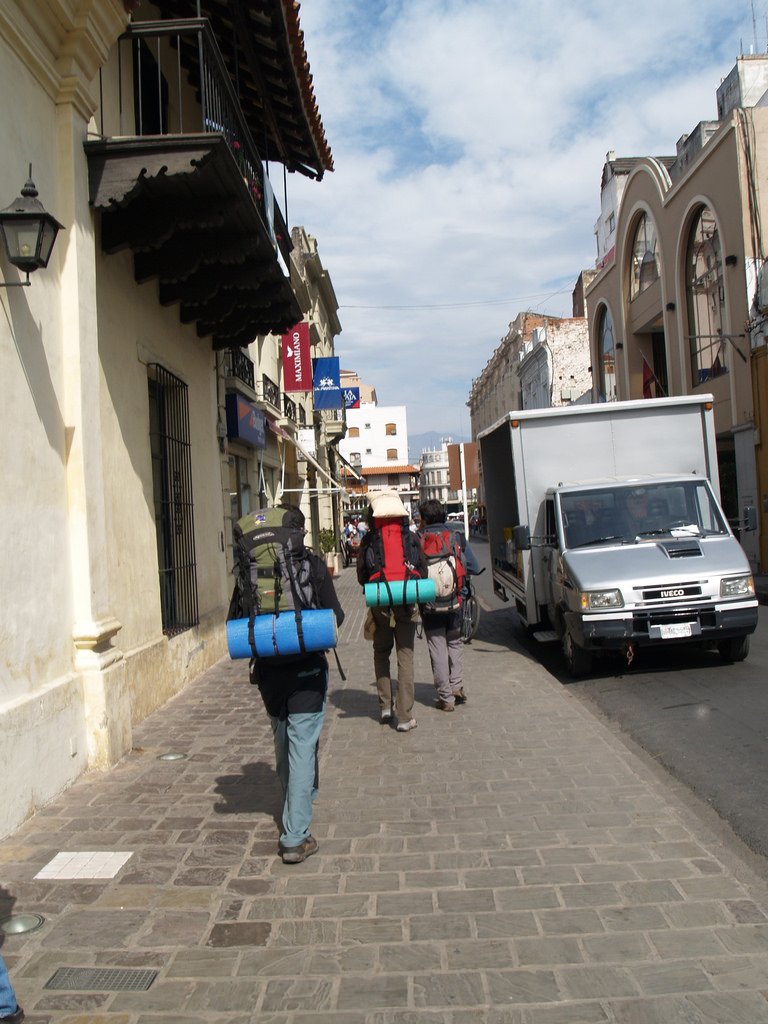How Hostels Have Turned Backpackers Into “Brokepackers”

In May 2014, having recently completed my master’s degree in anthropology, I pulled together what funds I had and escaped to Spain for a few weeks. I’d just checked into my six-bed dorm in a hostel in Barcelona. It was bright and clean and, for a hostel, had a lot of amenities, including free towels and even a hairdryer. The hostel, part of a European chain, boasted 400 beds in a five-story building. The common space, which featured sleek, modern furniture, was nearly empty until a large group of Dutch university students chattering about their two-week holiday burst through the front doors and headed off to their rooms.
As the noise of the students faded away, I noticed a guy—I’ll call him Gim—maybe in his mid-30s, sitting in a hammock suspended from the ceiling. He seemed agitated.
Gim and I got to talking, and we were soon comparing our early travel experiences, reflecting fondly on a time, about 10 years ago, when you could walk into a hostel and get a bed without having booked it months in advance. Our reminiscing brought us back to a time when smartphones were still rare, when there was no Wi-Fi (only internet cafes that charged obscene connection fees), and when people used maps—you know, made out of actual paper—not apps, to find their way around.
Gim insisted he was at the hostel only because everything else was full and he couldn’t find accommodation through Couchsurfing—an online platform and community where hosts and travelers can set up exchanges of sleeping spaces for cultural interactions and conversation. “Hostels these days just aren’t the same,” he said. “They aren’t for real backpackers anymore.”
Gim was onto something. In recent years, the part of the traveling public broadly referred to as “backpackers” has been transformed by a new class of travelers known as “flashpackers” (short-term travelers looking for a relatively upscale experience, also referred to as “poshpackers”). In response, some more traditional backpackers (longer-term travelers on minimal budgets) are differentiating themselves using a somewhat cheeky new label: “brokepackers.”
The flashpacker phenomenon stems from multiple factors, one of which is the growing accessibility of travel for well-heeled people in their 20s and 30s. Another is the rise of hostel chains and the resulting gentrification and commodification of hostels themselves, which increasingly cater to travelers who are looking for “nicer” accommodations that offer many of the comforts of home.
This shift has disproportionately affected those at the low end of budget travel, many of whom feel that these new accommodations lack authenticity. As hostels have become gentrified, many traditional backpackers have sought out places to stay that are not only more affordable but also what they consider more genuine.
Conceived of in 1909 by a German elementary school teacher, early youth hostels were never meant for backpackers at all. Instead, they were designed for students, providing educational experiences and room and board in exchange for a small amount of money and a contribution to the upkeep of the hostels themselves. In the first half of the 20th century, several formal hostel organizations were formed to make these affordable accommodations accessible to travelers. Backpacking as a form of established tourism didn’t become commonplace until the 1960s and ’70s. During that time, in the wake of widespread jet travel and the emergence of the so-called “hippie trail”—an overland journey many members of the hippie subculture took between Europe and South Asia—hostels set out to appeal to increasing numbers of travelers variously described as “drifters” and “wanderers”—and “backpackers.”
What exactly is a backpacker? Although this has never been a homogeneous group, some ethnographers have done a pretty good job of describing the typical backpacker. In a 2006 article, Camille O’Reilly, a sociologist who studies tourism, described backpackers as people who spend extended periods of time on the road (often counted in months, sometimes even years, rather than weeks) and travel on a very low budget. They are generally Westerners who frequently come from financially secure families.
Despite their differences, it’s not as if today’s flashpackers and brokepackers don’t have attitudes in common. Both groups are quick to distinguish themselves from conventional tourists: “I’m not a tourist, I’m a traveler” is a commonly expressed sentiment. Both groups are often intent on avoiding the more popular tourist sites and instead seek out novel cultural experiences. “They embrace serendipity,” O’Reilly writes. And, of course, they likely carry their belongings in backpacks.
Still, what has happened recently is that brokepackers have been displaced at hostels by short-term, city-hopping flashpackers. Even if these more affluent travelers look like the backpackers of yore, they’re different in many ways. They travel on a fixed schedule and want to stay in reasonably priced hostels that they can venture out from to sample the local culture (or what they think is the local culture).
Brokepackers, on the other hand, stick with more traditional backpacking practices. They are interested in cheap, long-term travel. They expect fewer amenities and are willing to stay in a wide range of accommodations that better-off travelers might not tolerate. Like traditional backpackers, brokepackers are inclined to hitchhike to save a buck or two, and they follow very loose itineraries—if they follow them at all.
The economic value of the emergent community of short-term, pack-wielding travelers hasn’t gone unnoticed by the tourism industry, and hostel owners have been understandably eager to provide flashpackers with the experiences they want. Appealing to better-off backpackers, however, requires more than just hairdryers—it means becoming more upscale while still offering some level of authenticity. A hostel in Prague, for example, offers classes in traditional Czech cooking. One in Mexico gives its guests discount tickets to football games so they can experience something “traditionally Mexican.” This trend has dramatically driven up the rates at many hostels. As an example, in 2008, I spent US$10 a night on a hostel in Mexico. Today that hostel, during the peak season, will run you a whopping 75 bucks a night to stay in a 20-bed dorm.
Not surprisingly, brokepackers tend to regard this trend with disdain—and not just because of the financial aspect. Many of them can afford to stay in more expensive hostels, but they choose not to, feeling that the commodification of hostels limits cultural opportunities and reduces the authenticity of the travel experience. And for some budget travelers, the higher prices have, in fact, put hostels out of reach.
Even though trendy hostel chains are overtaking their more affordable counterparts, there are still options for intrepid travelers. Much in the tradition of their drifter forebears, brokepackers have turned to seeking shelter in the homes of strangers or searching out the smaller, cheaper hostels along roads less traveled. Some of them volunteer on farms in exchange for room and board. Others travel with tents and camp out, literally living out of their packs. Backpackers looking for alternatives to hostels have become so numerous that organizations like Couchsurfing are now deluged with members looking for a place to crash.
Julia Giraldi, a veteran backpacker and a friend of mine since middle school, embodies the enduring ethos of low-budget travel. She has been on many backpacking trips; her longest was a year and a half traveling around Central and Eastern Europe followed by a few months in Southeast Asia. Along the way, she surfed couches and stayed, and often worked, in many hostels.
When I chatted with her before writing this piece, I asked her to name the best place she has ever stayed, and she told me about a hostel in northern Thailand. Giraldi admitted it wasn’t the most attractive place to crash. “Many people carrying packs these days would take one look at this place and leave,” she said. “It was basically half of a garage, and it was, like, two mattresses on the floor. The kitchen was a hot plate outside.” There was no privacy or even a lock on the front door, which she said forced everyone—guests and staff—to trust one another. Still, despite the modest facilities, the social experiences she enjoyed were truly memorable. One night, she said, the owner, a massage therapist by day, cooked pad thai for everyone staying at the hostel, gathering them into a small communal space to share the meal. The group, an eclectic mix of young and old backpackers from far-flung places, bonded, and they all went out to a jazz club after dinner.
Backpackers may be different from traditional tourists, but they still tend to share their experiences with other backpackers more than with locals—as in the case of Giraldi’s memorable experience. Backpackers, like tourists, participate in manufactured encounters that are labeled “authentic” when in actuality they are produced specifically for backpackers. Consider Thailand’s full-moon parties, which are celebrations almost exclusively aimed at backpackers, or Australia’s backpacker-focused Aboriginal cultural tours of the Outback.
All hostels (even if they are really affordable, like the one Giraldi mentioned) tend to create a concentration of backpackers; as a result, backpackers become an economic resource for locals, which can sometimes complicate how backpackers interact with the community. Travelers who choose to stay in hostels, as opposed to those who stay in locals’ homes, often miss out on opportunities for meaningful engagement with locals. Gentrified hostel chains create even more of a barrier to the surrounding population in that they offer standardized accommodations and they don’t tap into local culture or benefit local communities. Even huge international corporations are beginning to consider entering the hostel market. The hotel chain Hilton, for example, announced in early 2016 that they were considering opening hostel-like accommodations. It’s safe to say that if they do, these lodgings will probably not foster particularly meaningful interactions with locals.
In any case, despite the differences between brokepackers and flashpackers, most people who travel with backpacks express a yearning for experiences that other tourists don’t have and a hunger to learn from locals about the places they visit. Much like anthropologists conducting short ethnographies, backpackers possess a raw desire to immerse themselves in and learn about cultures foreign to them, even if they most often find themselves immersed in “backpacking culture” instead.



































